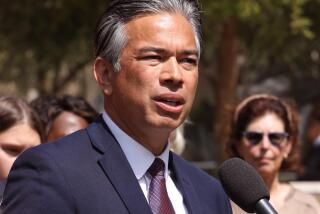Sacramento Fails the Test : Redistricting impasse may send this important issue to the courts
- Share via
Maybe it was too much to ask. The Legislature and Gov. Pete Wilson have failed, predictably, to come up with a redistricting agreement.
Yes, Democratic-backed plans that redivide Assembly, state Senate and congressional districts were approved Thursday by the Legislature--on strictly partisan votes. But Gov. Wilson, a Republican, is expected to veto them, and there’s not much hope for an override. That means the job of drawing new lines to reflect the population shifts revealed by the 1990 census likely is headed, by default, for the courts.
Reapportioning new districts every decade is never easy because there are so many political factors to weigh. This time around, it was made harder still by two factors: a Democratic-controlled Legislature pitted against a GOP governor and the federal Voting Rights Act, which requires the state to draw plans that give minority groups a chance to win in areas where they dominate.
Add to this the desire of incumbents of both parties to preserve their own districts and it made for a political stew certain to cause indigestion.
Democrats maintain they drew plans that accounted for both the rise in registration of Republicans statewide as well as new demands for minority representation. They threw up their hands on an agreement because, to meet Wilson’s demands, they would have had to make concessions to the GOP that they considered unacceptable. Wilson and the GOP say all they wanted were plans that would create competitive districts in which they have a chance to win.
Working within the same constraints, however, the Senate managed to reach a bipartisan agreement on how to draw new lines for its 40 seats.
There was also a chance that a plan for the 52-member congressional delegation could have worked because California’s disproportionate growth in the 1980s has added seven new seats to spread around. That means Republicans could make gains without causing undue hardship for Democrats.
But the main sticking point was over the plan for the 80-member Assembly, where partisanship frequently has stood in the way of taking care of legislative business. Many insiders believe there never was a chance that an agreement could be reached there.
No one expected reapportionment to be a cakewalk. But it is one of the most important duties of the Legislature and the governor. The vibrancy of the state’s democratic system is at stake in a proper reapportionment. In this, they have sorely failed. Now it’s likely to be in the hands of the state Supreme Court.
More to Read
Get the L.A. Times Politics newsletter
Deeply reported insights into legislation, politics and policy from Sacramento, Washington and beyond. In your inbox twice per week.
You may occasionally receive promotional content from the Los Angeles Times.










